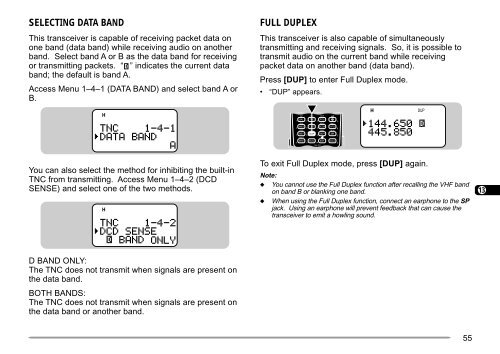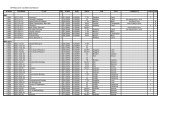Kenwood TH-D7A
Kenwood TH-D7A
Kenwood TH-D7A
Create successful ePaper yourself
Turn your PDF publications into a flip-book with our unique Google optimized e-Paper software.
SELECTING DATA BAND<br />
This transceiver is capable of receiving packet data on<br />
one band (data band) while receiving audio on another<br />
band. Select band A or B as the data band for receiving<br />
or transmitting packets. “ ” indicates the current data<br />
band; the default is band A.<br />
Access Menu 1–4–1 (DATA BAND) and select band A or<br />
B.<br />
You can also select the method for inhibiting the built-in<br />
TNC from transmitting. Access Menu 1–4–2 (DCD<br />
SENSE) and select one of the two methods.<br />
D BAND ONLY:<br />
The TNC does not transmit when signals are present on<br />
the data band.<br />
BO<strong>TH</strong> BANDS:<br />
The TNC does not transmit when signals are present on<br />
the data band or another band.<br />
FULL DUPLEX<br />
This transceiver is also capable of simultaneously<br />
transmitting and receiving signals. So, it is possible to<br />
transmit audio on the current band while receiving<br />
packet data on another band (data band).<br />
Press [DUP] to enter Full Duplex mode.<br />
• “DUP” appears.<br />
STA CON PACKET96 BCON<br />
7 9<br />
To exit Full Duplex mode, press [DUP] again.<br />
Note:<br />
◆ You cannot use the Full Duplex function after recalling the VHF band<br />
on band B or blanking one band.<br />
◆ When using the Full Duplex function, connect an earphone to the SP<br />
jack. Using an earphone will prevent feedback that can cause the<br />
transceiver to emit a howling sound.<br />
5<br />
1<br />
2<br />
3<br />
4<br />
5<br />
6<br />
7<br />
8<br />
9<br />
10<br />
11<br />
12<br />
13<br />
14<br />
15<br />
16<br />
17<br />
18<br />
19<br />
20<br />
21<br />
22<br />
23<br />
55

















